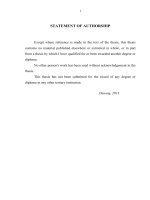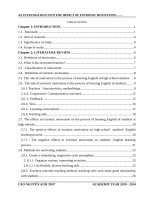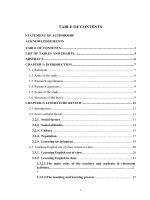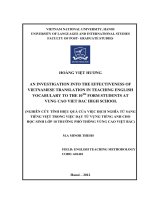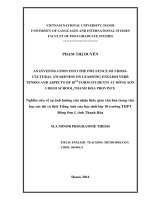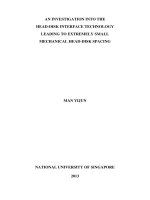LV An investigation into the pronunciation of English stops experienced by the students at Tuy Hoa industrial college
Bạn đang xem bản rút gọn của tài liệu. Xem và tải ngay bản đầy đủ của tài liệu tại đây (1.35 MB, 95 trang )
1
Chapter 1
INTRODUCTION
1.1. RATIONALE
Every language learner has a wish of achieving the most efficiency in
communication. To do that, learners have to pay much attention to using the
language as well as pronouncing them correctly. As far as the aspect of
connected speech is concerned, it is not easy for Vietnamese learners to
perform English sounds, especially English stops as well as to perceive and to
comprehend them in conversations. They meet so many difficulties in
pronunciation. One of those is caused by the influence of their mother tongue
on their language learning because each language has its own rules and
phonetic system which may cause a lot of obstacles to learners in practicing
and performing them correctly. More importantly, most of the learners do not
pay attention to how to pronounce English stops in the initial, middle or final
positions, i.e. devoicing them in the initial position, releasing them in final
position, connecting them, lengthening or shortening the vowels followed by
an English stop, etc. Accordingly, they may get trouble with speaking and
listening to native speakers.
Besides, the learners and teachers’ method as well as attitude towards
pronunciation teaching and learning are not good enough. From my own
experience and observation in classrooms of English in Tuy Hoa Industrial
College, the students are found to have few opportunities of practicing to
improve their pronunciation skill because the teachers tend to equip them with
knowledge of grammar and vocabulary without paying much attention to
practicing pronunciation. They tend to de-emphasize pronunciation in
language courses. Furthermore, their tests and examinations focus mainly on
2
writing and reading skills. As a result, the students do not concentrate their
time and energies on practicing pronunciation.
As a teacher of English, I would like to conduct this research to identify
the factors that cause problems which Vietnamese learners encounter when
producing English stops to give awareness not only to Vietnamese learners of
English, but also to the teachers of English about in learning and teaching
English stops to help learners of English improve their competence of
communicating efficiently with native speakers. Therefore, it is essential to
carry out an investigation into the pronunciation of English stops experienced
by the students at Tuy Hoa Industrial College. I hope that this study could
provide a fresh perspective on pronunciation as a curriculum area in language
learning and teaching.
1.2. AIMS, OBJECTIVES AND QUESTIONS OF THE STUDY
1.2.1. Aims
This study has been developed with the aim of helping students at Tuy
Hoa Industrial College in particular and learners of English in general
improve their pronunciation of English stops with the solutions to overcome
their common pronunciation mistakes of these sounds.
1.2.2. Objectives
This study is intended to:
- Describe and compare the English and Vietnamese stops.
- Discover the similarities and differences between English and
Vietnamese stops
-
Find out some causes and common mistakes made by students at
Tuy Hoa Industrial College in performing the English stops
3
- Suggest some solutions to mistake correction in pronunciation of
English stops experienced by the students as well as activities to enhance their
performance of these sounds.
1.2.3. Questions of the study
To achieve the aims and objectives mentioned above, this study tries to
answer the following questions.
1. What are the similarities and differences between English and
Vietnamese stops?
2. What are common mistakes made by students at Tuy Hoa Industrial
College in performing English stops?
3. What causes those mistakes?
4. What are the effective ways and activities that teachers of English
at colleges can apply to correct and improve students’
pronunciation of English stops?
1.3. THE SCOPE OF THE STUDY
This study just focuses on examining the perception and production of
English stops / p, b, t, d, k,
/ by students. In this study, the students at Tuy
Hoa Industrial College would be chosen as the representative informants.
1.4. DEFINITION OF TERMS
Stops or plosives are consonant sounds produced by stopping the
airflow in the vocal tract then separating rapidly. The term “plosive” is
reserved for oral (non- nasal) stops. Plosives include / p, b, t, d, k,
20:130]
/. [6:7,
4
1.5. ORGANIZATION OF THE STUDY
Chapter 1, Introduction, consists of the rationale, the aims and
objectives, the scope of the study, research questions and definitions of terms
and also the organization of the study.
Chapter 2, Literature and Theoretical background, provides a brief
literature review and theoretical knowledge for the matters of study.
Chapter 3, Research design and Methodology, presents the research
method, the hypotheses and the procedure of data collection and analysis.
Chapter 4, Findings and Discussion, discusses in the result of the data
analysis, then draws causes of making mistakes. In this chapter, the activities
which can be applied to improve students’ pronunciation are also included.
Chapter 5, Conclusion and Recommendations, gives brief conclusion of
the study. Besides, it also includes recommendations for improving students’
pronunciation
5
Chapter 2
LITERATURE REVIEW
2.1. REVIEW OF THE PREVIOUS STUDIES
According to Lightbown and Spada (1996), a child’s language
acquisition is mainly based on imitation, practice and innate capacities
without paying attention to the knowledge of phonetics. In contrast,
adolescence and adult learners’ process of second language learning is not the
same due to their developmental changes in the brain. In order to achieve the
goal of pronouncing as closely as native speakers, the learners need to be
provided good knowledge of the English sounds. This may possibly
contribute to the fact that apart from the course-books designed for only
speech training with little information on how a speech sound is produced,
most writers have discussed the articulation of speech sounds with details,
especially the issues of English stops.
In an early study of English speech sounds, Connor (1973) dealt with
the stops by starting with the English phonemes rather than concrete sounds.
In his study, the phonemes were focused on the variety of sounds by which
they are realized. In a practical view, Roach (1983) made a contrast between
the minimal pairs of English stops which can help the learners have
distinction between /p/ and /b/, /t/ and /d/, and / k/ and / /. He also studied
their distribution and variants.
In a view of error analysis, Ladefoged (1982) introduced some
important general phonetic notions of English stops. He analyzed specific
mistakes of English stops which foreign learners often encounter and showed
how to produce these sounds correctly in particular cases.
6
In the aspect of teaching pronunciation, Kenworthy (1992) focused on
the specific problems encountered by speakers of Arabic, Chinese, French,
German, etc. And he also examined the areas of difficulty in terms of
learning and teaching strategies. However, in this study, he has not addressed
the problems which Vietnamese learners often meet in pronouncing English
stops.
Research on phonetics and phonology by Carr (1999) described
English stops and gave the detailed distinction between aspirated and
unaspirated voiceless stops which is phonemic in Korean but allophonic in
English. The distinction is also held true for Vietnamese, although he did not
give any concern to Vietnamese.
More specifically, Gimson (1970) carefully described how to
pronounce English stops. The highlights of his study were the advice giving
parts to foreign learners. This material is not only useful for learners of
English but also for my study as the reference and guideline.
Martha C. Pennington (1993), in research “Realizations of English final
stops by Chinese speakers in Taiwan” discussed problems that learners may
have with the pronunciation of English stops, and proposed some pedagogical
implications concerning this group of sounds.
All in all, those studies have mostly examined production of English
stops and a few of them have mentioned about the contrastive information
concerning Vietnamese. Only in a recent cross-linguistic study, Giang (2003)
investigated the similarities and differences between English and Vietnamese
stops and discussed the problems of English stops encountered by the students
at Danang University. This research was really valuable for me to help
shaping my hypotheses and for reference.
7
Accordingly, we seek more solutions to help the Vietnamese learner of
English to perform their speaking as close to native speakers as possible. In
this study we did not require the students to produce the sounds sequences
with exact pronunciation as native speakers, but in somewhat like native
speakers’ pronunciation and intelligible.
2.2. THEORETICAL KNOWLEDGE
2.2.1. The production mechanism of stops in English and Vietnamese
All languages have pulmonic stops and the normal mechanism is
pulmonic egressive, that is, with air flowing outward from the lungs.
The complete articulation of a pulmonic egressive, plosive or stop
consonant consists of three stages:
1. The closing stage, during which the articulating organs move together in
order to form the obstruction; in this stage, there is often an on-glide or
transition audible in a preceding sound segment and visible in an acoustic
analysis as a characteristic curve of the formants of the preceding sound.
2. The holding or compression stage, during which lung action compresses
the air behind the closure; this stage may or may not be accompanied by
voice, i.e., vibration of the vocal cords.
3. The release or explosion stage, during which the organs forming the
obstruction part rapidly, allowing the compressed air to escape abruptly; if
stage (2) is voiced, the vocal cord vibration may continue in stage (3); if
stage (2) is voiceless, stage (3) may also be voiceless (aspiration) before
silence or before the onset of voice ( as for a following vowel), or stage (3)
may coincide with the onset of vocal cord vibration, as when a voiceless
plosive is followed without intervening aspiration by a vowel; again, an
8
off-glide or transition associates the plosive with a following sound.
[8:150]
The description of the production mechanism above is just a general
one because each sound in this group will have different phonetic variants
when it is distributed in different positions in a word.
2.2.2. Contrastive analysis of stop consonants in English and Vietnamese
Apart from using knowledge of our students and our ears in order to be
aware of their pronunciation problems, it is also useful to have some prior
knowledge of what elements of English phonetics and phonology are likely to
cause problems to the Vietnamese learners of English.
2.2.2.1. Similarities
As we have mentioned above, all languages in the world have stops. In
English and Vietnamese, the consonant system of stops consists of six
members: /b/, /p/, /t/, /d/, /k/, / / and each of them has different places of
articulation (see Table 2.1 below)
Table 2.1 The articulation of stops
MANNER OF ARTICULATION
STOPS
Bilabial
Alveolar
Velar
VOICELESS
/p/
/t/
/k/
VOICED
/b/
/d/
/ /
Basically speaking, both English and Vietnamese stops have the same
production mechanism. They are divided into three pairs, as we have seen,
according to the manner of articulation. Members of each pair can be
distinguished on voiceless and voiced features.
9
2.2.2.2. Differences
As mentioned above, the production mechanism of the stops in English
and Vietnamese is similar in general; however when distributed in different
contexts of words or in connected speech, English stops are affected by the
surrounding sounds and undergo some changes. As a result, each stop in
English has it own phonetic variants, which foreign learners of English,
especially Vietnamese learners hardly recognize in speaking and listening.
Firstly, in Vietnamese, final stops neither have a release burst nor have
a nasal release whereas English final stops are often produced with these
phonetic features (with audible or no audible release).
Secondly, the English and Vietnamese stops are distributed differently
due to the phonetic systems of both languages as described in Table 2.2 and
Table 2.3. Examine Table 2.2 and Table 2.3 below we can have some
comments as follows:
English stops are distributed in different positions in words, while
Vietnamese does not have a voiceless stop [p] in the initial position.
Therefore, Vietnamese learners may fail to correctly pronounce the voiceless
stops [p] in this position. They may produce the word “pen” like “Ben”
because they might not pay attention to the force of articulation. /p/ is
produced with a stronger breath effort than /b/.
Table 2.2 The distribution of English stops [8:151]
Stops
/p/
/b/
/t/
/d/
/k/
/ /
initial
pole
bowl
toll
dole
coal
goal
middle
lopping
lobbing
bitter
bidder
postcard
beginning
final
rip
rib
writ
rid
risk
rig
Position
10
Table 2.3 The distribution of Vietnamese stops [3:153, 226]
stops
/p/
/b/
/t/
/d/
/k/
/ /
initial
-
bóng
tắt
đúng
kẹo
gắng
middle
-
-
-
-
-
-
final
đập
-
tắt
-
tắc
-
position
In Vietnamese /p/, /t/, and /k/ appear at the end of words without
releasing. The learners often have tendency of dropping these sounds in the
final positions in English words. So they may perform words ending with
both voiced and voiceless stops identically. For example, they may perform
the two words “tend” and “tent” the same. If they pay attention to pronounce
these sounds they may insert /ʋ/ with the finals. For example, “cart” may be
produced like “carter” [ka:tʋ].
Furthermore, /p/, /t/, /k/ in English have the phonetic variants [p ],
[t ], [k ] in the initial position as “the fortis series /p, t, k /, when initial in an
accented syllable, are usually accompanied by aspiration.” [8:151], whereas
[p ], [t ], [k ] in Vietnamese are not allophones of /p/, /t/, /k/. That is, in
Vietnamese, [p], [t] and [k] are realization of the /p/, /t/ and /k/ morphemes
and [p ], [t ] and[k ] are realization of the distinct /p /, /t
and /k /
morphemes. If the learners do not pay particular attention to this phonetic
feature, they may raise a risk of causing misunderstanding. For example,
instead of pronouncing [p
n] for the word “pin” Vietnamese learners
pronounce [pin], which listeners may understand as “bin”.
11
/p/
Phonemes
Allophones
[p]
/t/
[p ]
[t]
[ ]
/k/
[k]
[k ]
Figure 2.1 English voiceless stop phonemes
(Adapted from [6:38])
Another feature that makes English stops different from Vietnamese
stops is consonant cluster. “Consonant cluster is a group of consonants with
no intervening vowel”[10]. In English consonant clusters such as [pl], [bl],
[dr], [ l] … are very popular. It is quite difficult for Vietnamese learners of
English to pronounce English consonant clusters because of no habit of
pronouncing these sounds in their mother tongue. They tend to insert the
vowel /ʋ/ after / p, b, d, k,
/ followed by / l, r /. For example, they may
pronounce the word “class” [klas] like [kʋlas].
Last but not least, Vietnamese learners of English hardly recognize the
influence of English stops on the length of the preceding sounds. The vowels
and even consonants closed by lenis / b, d,
/ are often produced longer than
those closed by fortis / p, t, k /. For example, the words “bad” and “bat” are
transcripted as [b d] and [b t]. Look at the transcriptions of the two words,
the vowel / / seems to be pronounced the same, but the vowel / / in “bad” is,
in fact, longer than the one in “bat”. “We could not symbolize the length
difference in a phonemic transcription because it is a conditioned difference:
whenever a fortis consonant follows in such words the preceding vowel is
shorter than when a lenis follows” [20:189]. Accordingly, Vietnamese
learners may perform these sounds incorrectly.
2.2.3. Syllable structure in English and Vietnamese
12
“Words can be cut up into units called syllables”[12]. A word contains
at least one syllable. Most speakers of English have no trouble dividing a
word up into its component syllables. Sometimes how a particular word is
divided might vary from one individual to another, but a division is always
easy and always possible. For example, the word “tomato” is divided into
three syllables [tʋ ma tʋ ].
A syllable is a unit of sound composed of a central peak of sonority
(usually a vowel), and the consonant that cluster around this central peak.
A syllable (σ) has its own internal structure: it can be divided into sub
syllabic parts as onset (O) and rhyme (R) within the rhyme we find the
nucleus (N) and coda (Co). Not all syllables have all parts; the smallest
possible syllable contains a nucleus only. A syllable may or may not have an
onset and a coda.
The general structure of a syllable consists of the following segments
which are shown in Figure 2.1.
σ
O
R
N
c(consonant)
v (vowel)
Co
c (consonant)
Figure 2.2 Internal structure of a syllable
(Adapted from [12])
13
Onset (obligatory in some languages, optional or even restricted in
others) is the beginning sounds of the syllable; the ones preceding the
nucleus. These are always consonants in English. The nucleus is a vowel in
most cases, although the consonants [ r ], [ l ], [ m ], [ n ], and the velar nasal
(the 'ng' sound) can also be the nucleus of a syllable. In the following words,
the onset is in bold; the rest underlined: card, drop, strain. If a word contains
more than one syllable, each syllable will have the usual syllable parts:
win.dow, to.ma.to, pre.pos.te.rous, fun.da.men.tal .
Rhyme (or rime) is the rest of the syllable, after the onset. The rhyme
can also be divided up: Rhyme = nucleus + coda. Nucleus is obligatory in all
languages. Coda (optional in some languages, highly restricted or prohibited
in others)
Vietnamese syllables are constructed as other languages. However, it
has a very strict structure with the presence of tone (T).
σ
R
O
c
T
N
Co
v
c
T
Figure 2.3 Internal structure of a syllable in Vietnamese
(Adapted from [1:46])
14
Unlike English, Vietnamese is a monosyllabic language. Syllables
often coincide with words. They consist of two mandatory components: a
tone and a nuclear vowel. The syllables may also contain two optional
components: an initial consonant and a final consonant or semivowel. The
initial consonant may or may not be accompanied by a secondary labial
articulation. Furthermore, O consists of only one consonant, whereas in
English, O may consists of more than one consonant (clusters). In addition,
there are clear-cut borderlines between words and each syllable ends without
releasing the final sounds, which could raise difficulties to Vietnamese
learners of English. They may tend to delete the final sounds and may forget
connecting words in natural speech. The possible negative transfer of the
phonetic features stops in Vietnamese syllabic structure is one of the serious
causes which make Vietnamese learners of English take no notice of the
assimilation and the liaison i.e. the linking of a final consonant in the
preceding word to the initial vowel of the following word. In term of fluency,
they may not be successful in performing as well as perceiving sounds in
connected speech.
2.3. SUMMARY
The chapter reviews some previous studies which are related to the
topic of the research. In addition, the contrastive analysis between English
and Vietnamese stops in terms of phonetic features in consonant systems and
syllabic structure gives an overview of the differences of stops in the two
language systems which can interfere second learners’ language learning
process, from which the researcher could draw some assumptions of potential
mistakes that Vietnamese learners of English may have.
15
Chapter 3
RESEARCH DESIGN AND METHODOLOGY
3.1. RESEARCH DESIGN AND METHOD
In this study, the qualitative and quantitative analysis method is used on
the basics of predictive contrastive analysis of English as the target language
and Vietnamese as the source language. The study starts with some
hypotheses drawn from the similarities and differences between English and
Vietnamese and our observation on the students’ mistakes and their
difficulties in pronouncing English stops. These hypotheses will be verified
with the help of qualitative and quantitative evidence extracted from data
collected from questionnaires, diagnostic test of the students’ perceptive skill
and production skill (direct recording of their actual performance). All the
data were then analyzed qualitatively and quantitatively. Qualitative
information consists of kinds of mistakes made by the students and
quantitative information is frequency of making mistakes, the number of the
students making mistakes and the rates of the number of the students to be
tested.
3.2. HYPOTHESES
Based on the comparison of the phonetic systems between English and
Vietnamese, the study sets forth the following hypotheses:
1. The students may fail to pronounce English stops correctly because
they do not pay much attention to the manner of articulation and the
positions of English stops in a word.
2. They may fail to pronounce English stops correctly by transferring
habits of pronouncing Vietnamese stops in Vietnamese words.
16
3. They may fail to correctly pronounce vowels followed by a voiced or
voiceless English stops.
3. 3. SUBJECT SELECTION AND DESCRIPTION
The subjects involved in the research are the first year students selected
randomly from the classes at Tuy Hoa Industrial College with groups of
different levels. The informants are non-specializing English students who are
required of having studied English for at least three years at high schools.
This subject selection of the study is based on the following reasons.
Firstly, according to the school syllabus, non-specializing English
students only study English in the first, the second and the third semesters.
Therefore, it is necessary to carry out the investigation into the first year
students.
Secondly, the informants were divided into groups of different levels
according to their background of studying English before entering the college
(three years, seven years and more than seven years) to serve the purpose of
the study: how to teach students of different levels to learn and practise
pronunciation of English stops effectively.
Thirdly, the subject was chosen in order to help the students overcome
the problems of stops pronunciation as soon as they begin their English
lessons at colleges.
Last but not least, the subject of the study would help provide some
necessary information about students’ background and attitudes towards
learning and practicing pronunciation in general and English stops in
particular, which contributes to the conducting of the survey of study.
17
Table 3.1 Group description
Group
Number of
students
Year
3 years
7 years
Over 7 years
6
16
8
First year
First year
First year
3.4. THE SAMPLE
The recordings were administered to a population of 30 students. As
mentioned above, the population from which the sample was drawn was the
first year students with groups of different levels and different backgrounds of
learning English. For the convenience of recording and analysis, the
researcher limited the number of the students on the diagnostic test. This was
also the limitation of the study. The sample in this study is the response and
instances of students’ actual performance of English stops in sound
sequences.
3. 5. PROCEDURE
The study was carried out with the following steps:
1. Review the relevant documents, books and theses to set forth the
hypotheses basing on the preliminary contrastive information.
2. Deliver the questionnaires and collect the data to test the hypotheses
about the students’ situation of learning.
3. Implement the diagnostics tests from isolated words, sentences to
free talks that contain problematic sounds on production skill
(recording students’ actual performance) and on perceptive skill to
collect the data.
4. Analyze the data to get the evidence to test the hypotheses.
5. Discuss the result of findings.
18
6. Suggest solutions to the problems to improve the matter of the
study.
3.6. METHOD OF DATA COLLECTION
The data of the study were obtained using 2 measurement instruments:
survey with questionnaires and diagnostic test.
The questionnaires were issued to the population of 100 students at Tuy
Hoa Industrial College. In order not to make the students get confused, the
researcher gave careful explanation of all the questions posed to the students.
Moreover, the students had as much time as they need to think over the
questions before they could make final decisions on the options or to show
their point of view to open-ended questions. (See Appendix A for the design
of the questionnaire.)
The diagnostic test was designed to test both of the students’ perceptive
skill and production skill. (See Appendix B for the design of the diagnostic
test.)
With the researcher’s intention, part 1 was to test the students’
perception of the stops. In this part, the students were required to listen to the
sentences with words containing stops which seemed to cause potential
problems.
Part 2 was for testing the students’ actual performance of producing
English stops. The students were tested with three kinds of tests. The first test
was tended to test how the students perform minimal pairs which contain
stops. The second contained a sentence list to test their performance in the
aspect of connected speech.
And the third was designed to test their
performance of the stops in connected speech by talking about a chosen topic
19
naturally. 30 students were chosen as representative informants of the three
different levels.
The word list in part one consists of 8 sentences for testing the
students’ perception skill of sounds /b /and /p/, 7 sentences for /t/ and /d/, and
7 sentences for /k/ and / /. The word list in Section 1 Part 2 consists of 6 pairs
of words for each minimal pair of phonemes. This test is designed to examine
the following dimensions. (See Table 3.2 below)
Table 3.2 Requirements of the minimal pair test
Stops
/p-b/
/t-d/
words
transcriptions
pin
/p n/
aspirated
bin
/b n/
partially devoiced
pen
/pen/
aspirated
Ben
/ben/
partially devoiced
pear
/peʋ/
aspirated
bear
/beʋ/
partially devoiced
cap
/k p/
released
cab
/k b/
released
pup
/p̚p/
vowel shortening
pub
/p̚b/
vowel lengthening
Poppy
/p p /
vowel shortening
Bobby
/b b /
vowel lengthening
tore
/t :/
aspirated
door
/d :/
partially devoiced
tarts
/t :ts/
aspirated
darts
/d :ts/
partially devoiced
cart
/k :t/
vowel shortening
card
/k :d/
vowel lengthening
write
/ra t/
released
Requirements
20
/k- /
ride
/ra d/
released
train
/tre n/
aspirated
drain
/dre n/
partially devoiced
trunk
/tr̚ k/
aspirated
drunk
/dr̚ k/
partially devoiced
cold
/kʋ ld/
aspirated
gold
/ ʋ ld/
partially devoiced
coat
/kʋ t/
aspirated
goat
/ ʋ t/
partially devoiced
curl
/k :l/
aspirated
girl
/
partially devoiced
class
/kl :s/
aspirated
glass
/ l :s/
partially devoiced
back
/b k/
released
bag
/b
released
:l/
/
clock
/kl k/
vowel shortening
clog
/kl
vowel lengthening
/
The sentence list in Section 2 consists of 10 sentences containing
problematic stops. For convenience, each sentence was used to test one or two
requirements. (See Table 3.3)
Table 3.3 Requirements of the sentence test
Sentences
Requirements
1.
labialization of [t]
2.
labialization of [d]
3.
Audible release of [b]
4.
Linking [sl p n], labialization of [d]
5.
Linking and mutual assimilation; [k ld ju:] changes to [k ld u:]
6.
Devoicing [d]
21
7.
Audible release of [d]
8.
Linking [d l vʋd n]
9.
Linking [dr
10.
Linking [ etʋ ], labialization of [t]
k t ]
All the words and sentences in section one and two were taken out from
the books “Sounds English” by J. D. O’ Connor and Fletcher and “Ship or
Sheep” by Ann Baker which makes the assessment and evaluation on the data
collecting reliable. For each section (section one and section two in part two)
of the test, the students were asked to read aloud the words and sentences so
that the recording could be made.
The topic list in section three, part two consists of 5 topics which are
about things and people around them. This section was considered the most
important part of the diagnostic test because language is not just appeared in
isolated words. According to Pennington “language is produced and
interpreted with reference to a larger meaningful context” [17], therefore, the
students were asked to talk freely about one of the topics in the topic list in
order to test if they could perform English stops in connected speech or not.
In the scope of the study, all the recordings were then analyzed and
focussed on the mistakes of the stops only.
3.7. DATA COLLECTION
The data collection was executed on the subjects mentioned above. The
questionnaires were delivered to the students in May, 2007 after they had had
nearly ten months of getting accustomed to their learning environment at the
college. The diagnostic test was administered in June, 2007 on the ground of
the determined research design methodology.
22
The collecting of the corpus was carried out in four stages:
Stage 1: The students were asked to pronounce the minimal pairs in the
word list after having 3 minutes to read through it;
Stage 2: The students were asked to read each sentence in the sentence
list after having 3 minutes to read through it;
Stage 3: Each of the students were asked to talk freely about a topic
they chose from the topic list after having 10 minutes to prepare and write
notes that was necessary for their talk;
Stage 4: The students were asked to listen to the tape and underline the
words they heard on the hand-outs delivered.
The diagnostic test was all recorded with the software “Polderbit Sound
Recorder and Sound Editor Version 4.0.0.90” and a microphone (Salar
Somic) connected to a laptop (hp). The recordings would make it possible for
the students’ performance to be transcribed, and then be collated with the
version produced by the English model tape as the baseline data. In addition,
the study took advantage of effective software “Goldwave” and “Speech
Analyzer 2.2 and 2.7” which can measure the phonic production of students.
The test and transcription were completed at the end of June 2007.
3.8. DATA ANALYSIS
Data analysis was carried out using the procedure of tallying
frequencies, recording the results, presenting the data in frequency and
percentage distribution tables, and analyzing and interpreting the data in the
light of the research objectives.
23
The first survey part was assessed in the following categories:
1. Students’ background (the length of their English learning process and
their background)
2. Students’ attitude toward learning English (their interest and attention
to the skill as well as their energy of pronunciation practice)
3. Teachers’ method and course books (the teacher and material roles in
teaching and learning English pronunciation)
4. Students’ knowledge of English stops and difficulties (students’
difficulties and causes to the problem)
The data collected from this part were used to provide the preliminary
information about the causes of students’ difficulties and also to give evidence
to the hypotheses.
Because the purpose of the study is to teach and to learn pronunciation
effectively in classes of different levels, the data collected in the second part
was analyzed according to three groups as described in the previous part. The
second component of the diagnostic test was made to check the students’
actual performance in pronouncing the stops in isolated words and sentences
and then in free talks. It is inevitable to accept that the students could make
other kinds of pronunciation mistakes, but we did not take such mistakes into
consideration. The mistakes were examined and totalled up to reinforce the
hypotheses. Accordingly, the students’ actual performance was judged with
qualitative and quantitative dimensions by recording, listening and comparing
carefully with the native speakers’ version. Along with this part, the
demonstration of the performance with the help of computer software like
“Speech Analyzer” and “Goldwave” were used to support our decisions on
students’ errors (as shown in Figure 3.1.a and Figure 3.1.b)
24
Figure 3.1.a Audio signal of the word “pen”
performed by a student
Figure 3.1.b Audio signal of the word “pen”
performed by a native speaker
3.9. VALIDITY AND RELIABILITY
The data collection was carried out with 100 students taking part in the
questionnaires and 30 students in performing their pronunciation in terms of
perceptive and productive skill. These students were divided into three groups
to make the collation and verification more reliable. However, although the
students were selected in three groups of different levels and backgrounds,
they were required to do the same diagnostic test. They were treated equally
because they have to follow the same syllabus at the college without
mentioning their abilities. Also, we administered the research among the nonspecializing English students at Tuy Hoa Industrial College only, which
cannot be generalized to all the students at colleges. This is also the limitation
25
of the study. Nevertheless, the research was carried out objectively on the
data collected without the researcher’s interference. So the results of the
findings and recommendations might meet the demand of pronunciation
teaching and learning at colleges.
